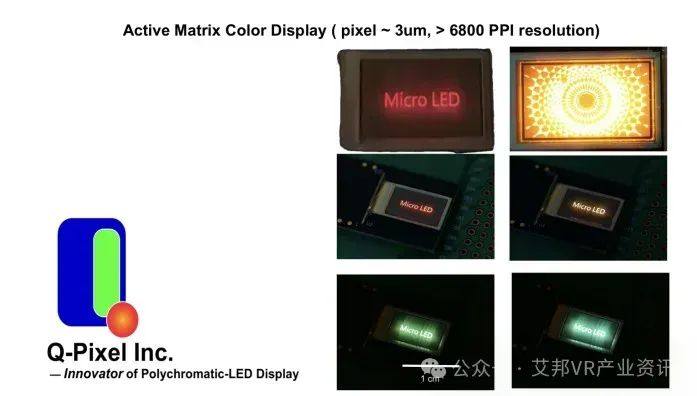On April 15th, Q-Pixel, a Micro LED display startup, announced the successful development of the world's highest-resolution active-matrix full-color display.

The display developed by Q-Pixel boasts a pixel density of 6800 pixels per inch (PPI), far surpassing current state-of-the-art displays like those used in Apple Vision Pro, which has a density of approximately 3380 PPI. Importantly, Q-Pixel's display is entirely fabricated using micro LED pixels.
Unlike most advanced VR displays that use micro-organic LEDs (micro-OLEDs), Q-Pixel's display is composed entirely of III-V compound micro LED pixels. III-V micro LEDs, synthesized from inorganic materials, offer several advantages over OLEDs, including faster response times, higher brightness, longer lifespan, and superior energy efficiency. From a physics perspective, inorganic III-V micro LEDs have long been considered the ideal display technology, but they have lacked a clear path to commercialization.
The main challenges to commercializing micro LED displays come from the traditional approach of assembling full-color pixels using individual monochromatic red, green, and blue (RGB) LEDs. For high-resolution displays requiring small (< 50 um) pixels, the assembly, testing, and repair of millions of RGB micro LED subpixels become a complex, labor-intensive, and expensive process. Moreover, the physical space required for three RGB subpixels restricts the display's pixel density, posing an obstacle to realizing high-resolution displays. Q-Pixel has overcome both hurdles by replacing three RGB subpixels with individual, fully color-tunable pixels.
Dr. Michelle Chen, the Chief Technology Officer of Q-Pixel, stated that their approach is based on a disruptive tunable polychromatic LED (TP-LED) pixel: a single pixel capable of emitting light across the full color spectrum without the need for any additional subpixels, quantum dots, color filters, polarizers, or chip stacking. In addition to possessing all the inherent advantages of III-V LED technology, Q-Pixel's single TP-LED greatly simplifies the assembly process of Micro LED displays, reduces manufacturing costs, and achieves a world-record pixel density.
Previously, in May 2023, Q-Pixel launched its then-world-record 5000 PPI full-color micro LED display, and in the same year, in November, they announced the release of a passive 10,000 PPI micro LED display made from the world's smallest full-color pixels with a diameter of 1μm, continuously surpassing their own record for the highest pixel density.
Currently, by launching the world's highest-resolution (6800 PPI) active-matrix full-color display, Q-Pixel has achieved two significant milestones. Firstly, the company has demonstrated that ultra-high-resolution active-matrix displays can be produced based on micro LED technology. Secondly, Q-Pixel has proven that their TP-LED pixel technology surpasses more mature display technologies like OLED, achieving a world-record pixel density.
Translated from: Yahoo
The original article was first published on the WeChat official account (Aibang VR Industry News):Q-Pixel has launched the world's highest-resolution (6800 PPI) full-color Micro LED display.


